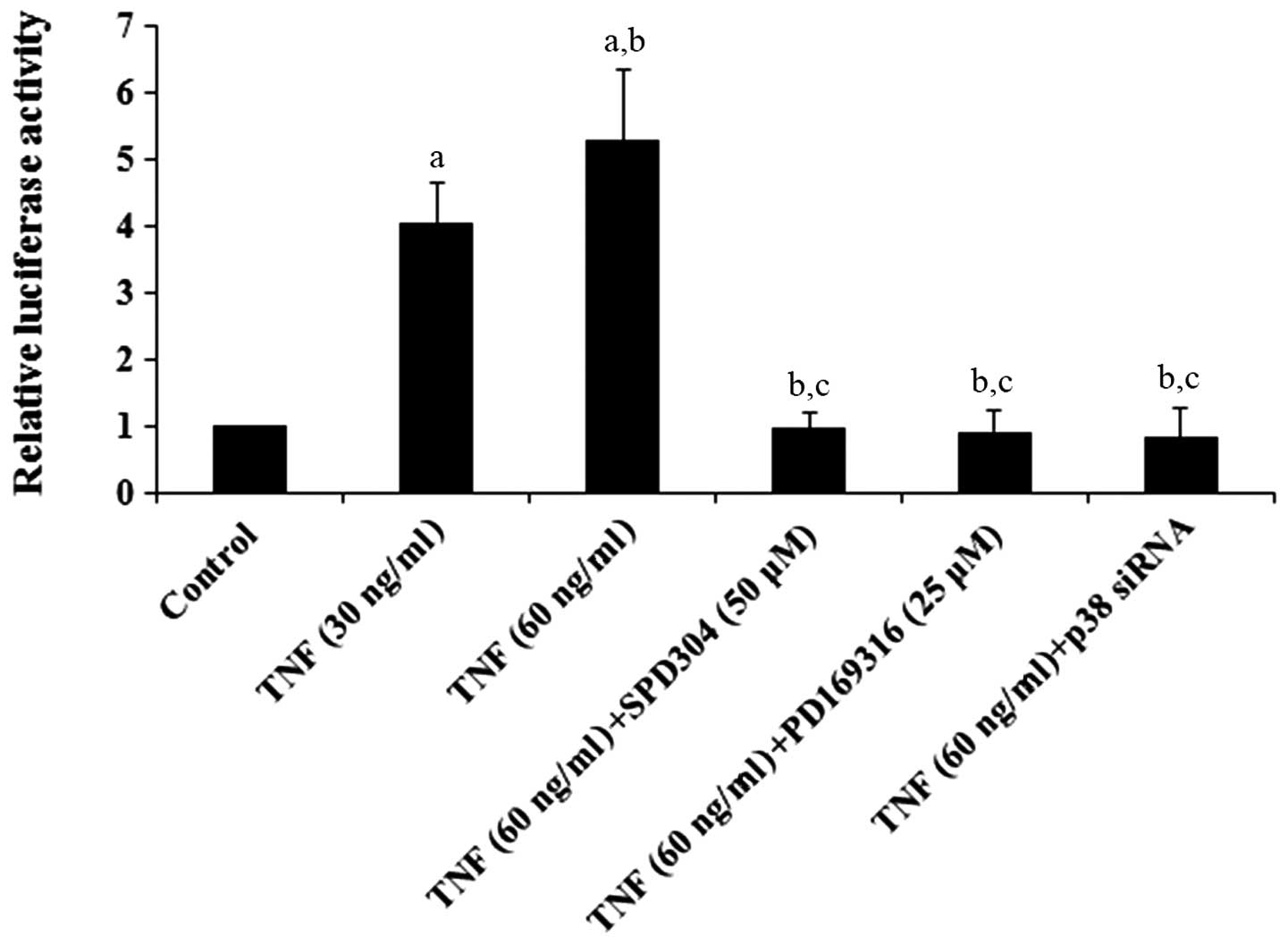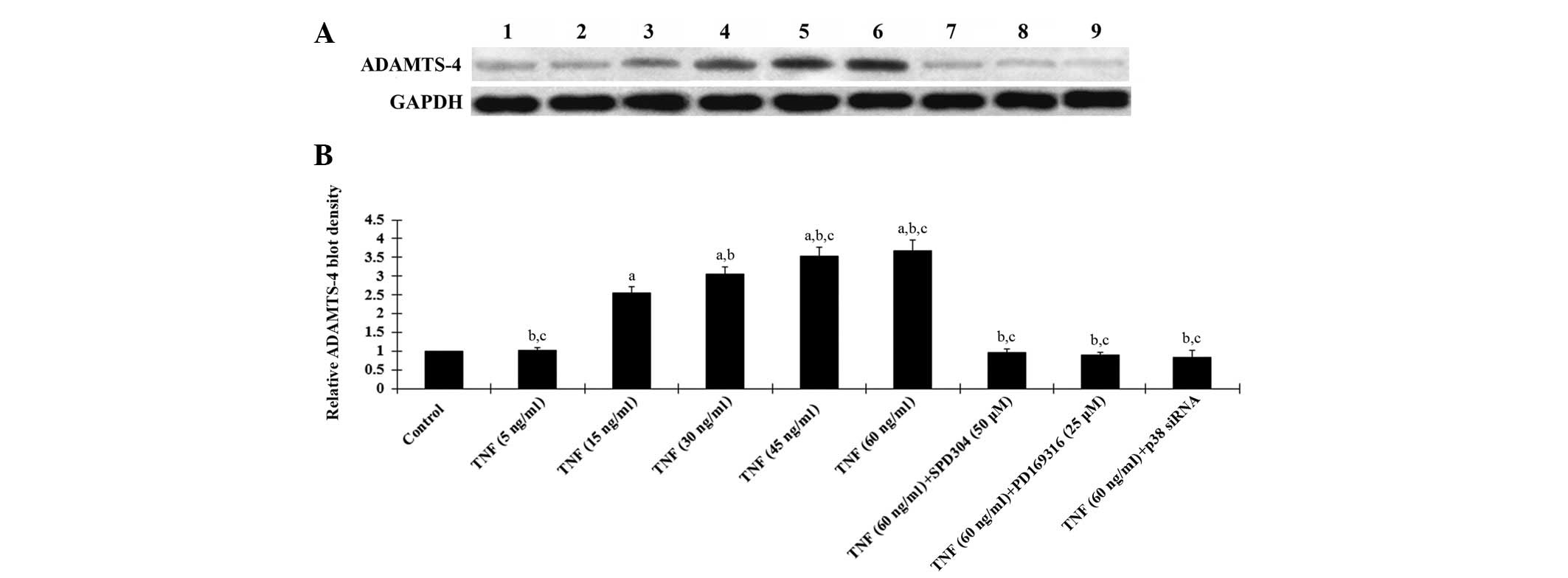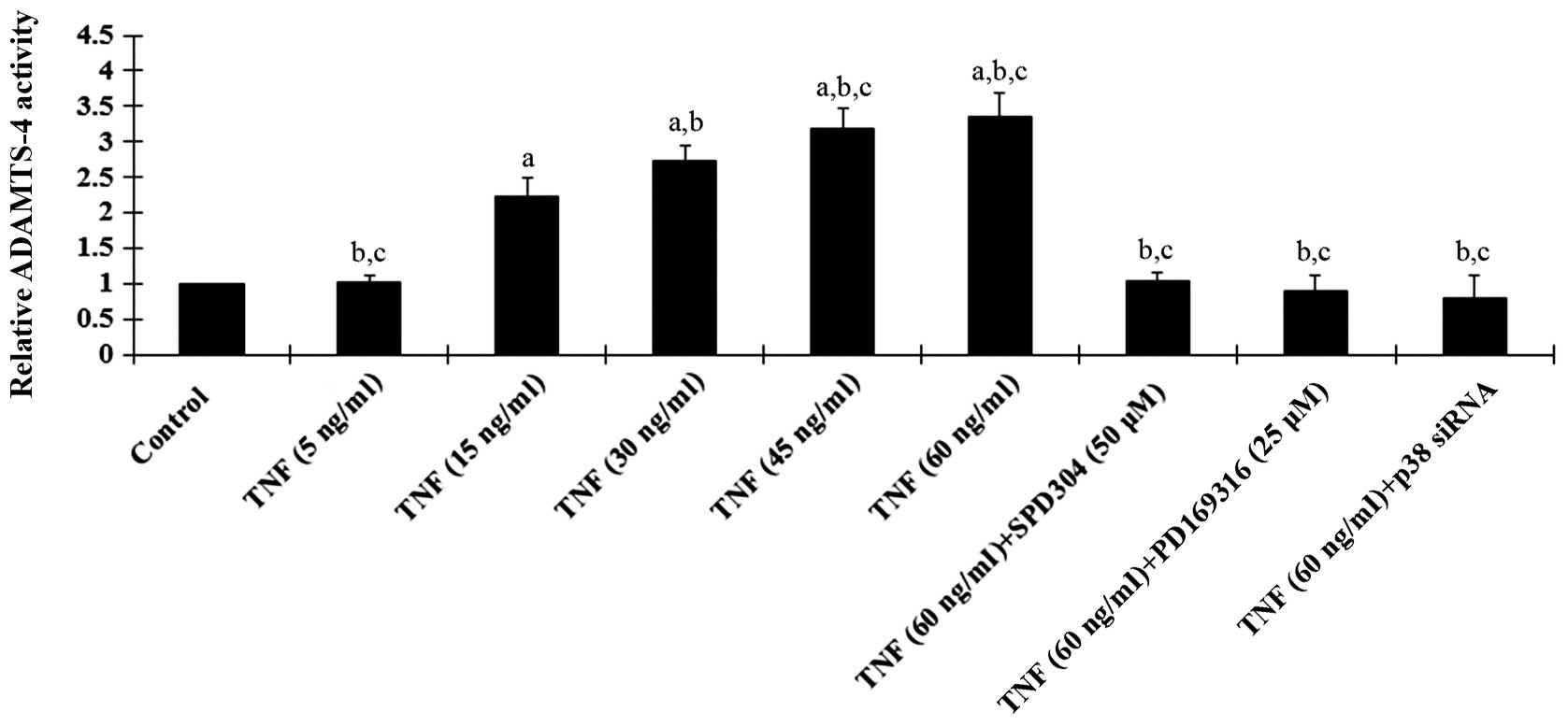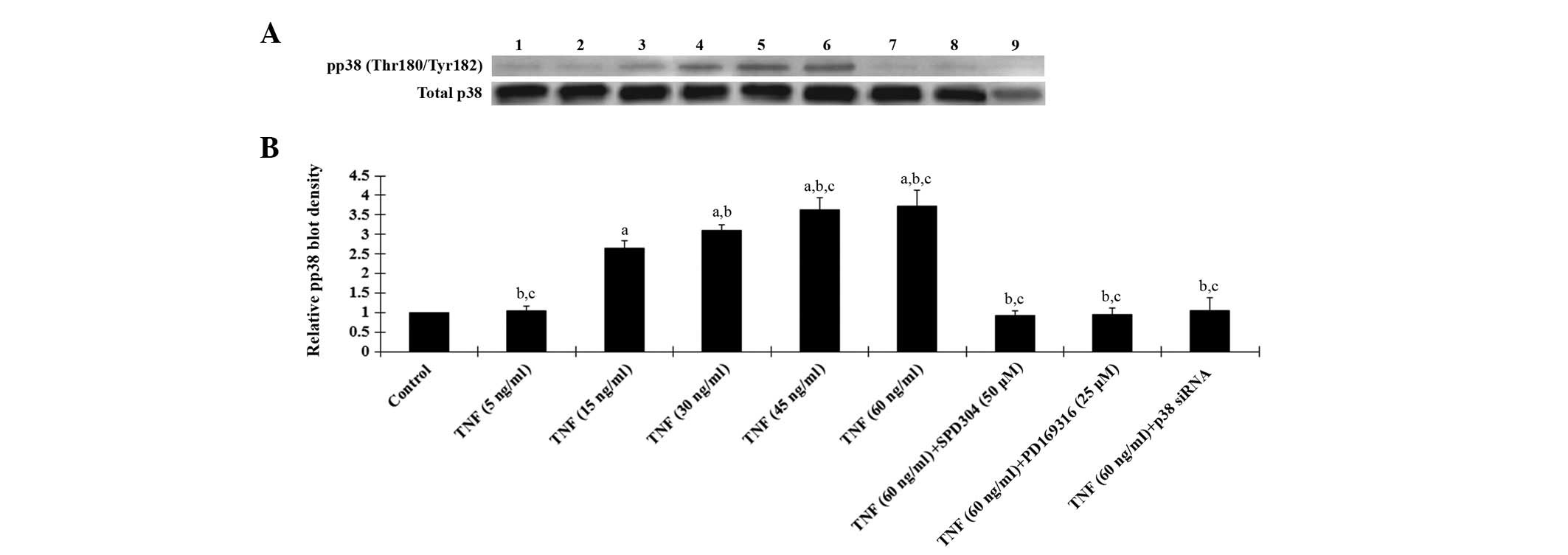Tumor necrosis factor-α induces ADAMTS-4 expression in human osteoarthritis chondrocytes
- Authors:
- Published online on: October 14, 2013 https://doi.org/10.3892/mmr.2013.1729
- Pages: 1755-1760
Abstract
Introduction
Osteoarthritis (OA) is the most common degenerative disease affecting articular cartilage and is characterized by disrupted cartilage extracellular matrix homeostasis, ultimately resulting in the loss of cartilage without effective replacement (1–4). OA is caused in part by the exposure of chondrocytes to inflammatory cytokines, including interleukin-1β (IL-1β) and tumor necrosis factor (TNF-α), which stimulate chondrocyte responses that promote catabolism of type II collagen and proteoglycans, thereby compromising cartilage extracellular matrix integrity and tissue homeostasis in OA (2). TNF-α is crucial in cartilage degradation. It promotes the expression of cytokines and chemokines in synovial cells and chondrocytes, thereby maintaining the renewal of local inflammatory mediators (5). The presence of TNF-α correlates with a general loss of cartilage matrix molecules, including type II collagen and aggrecan (5). TNF-α is produced by numerous cell types, including macrophages, lymphocytes, fibroblasts and keratinocytes in response to inflammation, infection and other environmental stresses (6). TNF-α acts by binding to its receptors, TNFR1 (p55) and TNFR2 (p75) on the cell surface. The majority of cells express TNFR1, which is believed to be the major mediator of the cytotoxicity of TNF-α (6). A previous study demonstrated that p55 TNF-α receptor expression is significantly increased in OA chondrocytes ex vivo. Enhanced expression of p55 may contribute to OA cartilage degradation (7).
The pathogenesis of OA is poorly understood, however a major feature is the loss of the two most important components of cartilage extracellular matrix: Type II collagen and aggrecan (8). Aggrecanases represent a class of proteinases belonging to the a disintegrin and metalloproteinase with thrombospondin motifs 4 (ADAMTS) family. Previous studies have demonstrated that ADAMTS 1, 4, 5, 8, 9 and 15 possess aggrecanase activity (9,10). Song et al demonstrated that the knockdown of aggrecanase-1 (ADAMTS-4), aggrecanase-2 (ADAMTS-5) or both attenuates the degradation of aggrecan in human cartilage stimulated by TNF-α and oncostatin M (11). It has been stated that ADAMTS-4 is selectively overexpressed in human OA cartilage and is positively correlated with the degree of cartilage destruction, whereas ADAMTS-5 is similarly expressed in normal and OA cartilages (12). The results suggest that ADAMTS-4 is a major aggrecanase in human OA cartilage and its induction is involved in the pathogenesis of OA.
TNF-α and ADAMTS-4 are thought to be important in OA cartilage degradation. For the first time, to the best of our knowledge, we explored the interaction between the two proteins by examining the effect of TNF-α on ADAMTS-4 expression and activity in human osteoarthritic chondrocytes.
Materials and methods
Reagents
Recombinant human TNF-α, TNFR1 inhibitor SPD304, phosphatidylinositol-3 kinase (PI3K) inhibitor LY294002, protein kinase C inhibitor Go6983, mitogen-activated protein kinase (MAPK) inhibitor PD098059 and p38 MAPK inhibitor PD169316 were purchased from Sigma (St. Louis, MO, USA). TRIzol reagent for RNA isolation and the SYBR Green Master mix were purchased from Invitrogen (Carlsbad, CA, USA) and Applied Biosystems (Foster City, CA, USA), respectively. Anti-ADAMTS-4 (PA1-1749A) antibody was purchased from Thermo Fisher Scientific (Rockford, IL, USA). Anti-phospho-p38 (Thr180/Tyr182; no. 9212) antibody, anti-p38 (no. 8690) antibody and SignalSilence® p38 mitogen-activated protein kinase (MAPK) siRNA (no. 6564) were purchased from Cell Signaling Technology (Danvers, MA, USA). The SensoLyte® 520 aggrecanase-1 assay kit (no. 72114) was purchased from AnaSpec Inc. (Fremont, CA, USA). Human ADAMTS-4 promoter-luciferase reporter (with the ADAMTS-4 promoter sequence from 726 nucleotides upstream to 406 nucleotides downstream of the transcription start site inserted upstream of the luciferase cDNA) was generated as previously described (13). A dual-luciferase reporter assay system was purchased from Promega (Madison, WI, USA). Lipofectamine 2000 transfection reagent was purchased from Invitrogen.
Cell culture and treatment
Human osteoarthritic chondrocytes (402OA-05a) and chondrocyte growth medium (411–500) were purchased from Cell Applications Inc. (San Diego, CA, USA). The cells were treated with TNF-α in different concentrations (5, 15, 30, 45 and 60 ng/ml) for different lengths of time (1, 6, 12, 18 and 24 h). All kinase inhibitors were dissolved in dimethyl sulfoxide (DMSO; final concentration of DMSO 0.05%). For kinase inhibitor treatment, chondrocytes were pretreated with the kinase inhibitor for 30 min and then incubated with the kinase inhibitor and TNF-α (60 ng/ml) for 18 h. Chondrocytes treated with TNF-α (60 ng/ml) + DMSO (0.05%) were used as a control in the experiments.
Real-time quantitative RT-PCR
RNA were prepared using TRIzol reagent followed by purification with TURBO DNA-free System (Ambion, Austin, TX, USA). The cDNAs were synthesized using SuperScript II reverse transcriptase (Invitrogen). Real-time quantitative PCR was performed on an Abi-Prism 7700 Sequence Detection System using the fluorescent dye SYBR Green Master mix (Applied Biosystems) as described by the manufacturer. The results were normalized against that of the housekeeping gene glyceraldehyde-3-phosphate dehydrogenase (GAPDH) in the same sample. The primers used were as follows: for human ADAMTS-4, 5′-GCAACGTCAAGGCTCCTCTT-3′ (forward) and 5′-CTCCACAAATCTACTCAGTGAAGCA-3′ (reverse); for human GAPDH, 5′-GACTCATGACCACAGTCCATGC-3′ (forward) and 5′-AGAGGCAGGGATGATGTTCTG-3′ (reverse). The mRNA level of treated cells was shown as fold changes to that of untreated control cells (designated as 1). Each experiment was repeated three times in triplicates. Results are expressed as the mean ± SD.
Luciferase reporter assay
Human osteoarthritic chondrocytes were transfected with human ADAMTS-4 promoter-luciferase reporter plasmids using Lipofectamine 2000 transfection reagent (Invitrogen) and then treated with TNF-α (30 or 60 ng/ml) for 18 h. Plasmid PRL-CMV encoding Renilla reniformis luciferase (at one-fifth molar ratio to test plasmids) was co-transfected with test plasmids in each transfection as an internal control for data normalization. Luciferase assays were performed with a dual-luciferase reporter assay system (Promega) according to the manufacturer's instructions. Each experiment was repeated three times in duplicates. Untreated human osteoarthritic chondrocytes were used as a control.
ADAMTS-4 activity assay and western blot analysis
ADAMTS-4 activities in cell culture supernatants were determined using a SensoLyte® 520 aggrecanase-1 assay kit (AnaSpec Inc.) according to the manufacturer's instructions. In western blot analyses, human osteoarthritic chondrocytes were lysed in 250 μl of 2X SDS loading buffer (62.5 mm TrisHCl, pH 6.8, 2% SDS, 25% glycerol, 0.01% bromophenol blue, 5% 2-mercaptoethanol) and incubated at 95°C for 10 min. An equal amount of proteins (100 g) for each sample were separated by 8–15% SDS-polyacrylamide gel and blotted onto a polyvinylidene difluoride microporous membrane (Millipore, Billerica, MA, USA). Membranes were incubated for 1 h with a 1:1,000 dilution of primary antibody and then washed and revealed using secondary antibodies with horseradish peroxidase conjugate (1:5,000, 1 h). Peroxidase was revealed with an ECL kit (GE Healthcare, Pittsburgh, PA, USA). Proteins were quantified prior to being loaded onto the gel.
Statistical analysis
Statistical analyses were performed with SPSS for Windows 10.0 (IBM, Chicago, IL, USA). Data values were expressed as the means ± SD. Comparisons of means among multiple groups were performed with one-way ANOVA followed by post hoc pairwise comparisons using Tukey's tests. P<0.05 was considered to indicate a statistically significant difference.
Results
TNF-a increases ADAMTS-4 mRNA expression
Cultured human osteoarthritic chondrocytes were treated with TNF-α in different concentrations (5, 15, 30, 45, 60 ng/ml) for different lengths of time (1, 6, 12, 18 and 24 h). ADAMTS-4 mRNA levels were examined using real-time quantitative RT-PCR. The ADAMTS-4 mRNA level of treated cells was shown as fold changes to that of untreated control cells (designated as 1). As displayed in Table I, TNF-α in the concentration range of 5 to 45 ng/ml increased the ADAMTS-4 mRNA level in a statistically significant dose- and time-dependent manner within 18 h of treatment, which was completely eradicated by TNFR1 inhibitor SPD304. By contrast, TNF-α demonstrated no significant effect on ADAMTS-4 expression in normal human chondrocytes and its effect on ADAMTS-5 expression was inconsistent in normal and osteoarthritic human chondrocytes (data not shown).
Table IRelative ADAMTS-4 mRNA levels in human osteoarthritic chondrocytes in the presence of TNF-α with or without TNF receptor inhibitor. |
Signaling pathways involved in TNF-a-induced ADAMTS-4 expression and promoter activity
To determine the signaling pathways involved in the promoting effect of TNF-α on ADAMTS-4 expression, we examined the ADAMTS-4 mRNA levels in human osteoarthritic chondrocytes treated with TNF-α (60 ng/ml) with or without different kinase inhibitors or siRNA for 18 h. As displayed in Table II, inhibition of protein kinase C (Go6983, 250 nm), MAPK (PD098059, 25 μm) and PI3K (LY294002, 50 μm) had no significant effect on the ADAMTS-4 mRNA level. By contrast, inhibition of p38 MAPK by the selective inhibitor PD169316 (25 μm) or p38 MAPK-specific siRNA completely blocked the promoting effect of TNF-α on ADAMTS-4 expression. Luciferase reporter assays demonstrated that TNF-α dose-dependently increased the ADAMTS-4 promoter activity, which was eliminated by SPD304, PD169316 or p38 MAPK siRNA (Fig. 1). Western blot analyses demonstrated that TNF-α treatment for 18 h dose-dependently increased ADAMTS-4 expression in human osteoarthritic chondrocytes, which was blocked by SPD304, PD169316 and p38 MAPK siRNA (Fig. 2). A similar data trend was observed with ADAMTS-4 activities in the cell culture media (Fig. 3).
Table IIRelative ADAMTS-4 mRNA levels in human osteoarthritic chondrocytes in the presence of TNF-α with or without kinase inhibitors or siRNA. |
Activation of p38 MAPK in TNF-a-induced ADAMTS-4 expression
Phosphorylation and activation of p38 MAPK is involved in TNF-α-induced biological effects (14,15). As displayed in Fig. 4, western blot analyses demonstrated that TNF-α treatment for 18 h dose-dependently increased phosphorylated p38 MAPK (Thr180/Tyr182) levels in human osteoarthritic chondrocytes, which was blocked by SPD304, PD169316 or p38 (MAPK) siRNA. Fig. 4 also demonstrates that the p38 siRNA knocked down >70% of endogenous p38 MAPK expression. Taken together, the results indicate that TNF-α induces ADAMTS-4 expression and activity in human osteoarthritic chondrocytes at the transcriptional level via TNFR1 by a p38 MAPK-dependent mechanism.
Discussion
Cartilage degradation in OA constitutes a major structural change in the joint, which may severely impair its function and cause pain and disability (16). Among the inflammatory mediators associated with OA, TNF-α is an established key mediator for cartilage (5). ADAMTS-4 is believed to be important in the degradation of aggrecan during the progression of joint diseases (17). In the present study, we provided, to the best of our knowledge, the first evidence for a regulatory effect of TNF-α on ADAMTS-4 expression and activity in human osteoarthritic chondrocytes.
TNF-α is produced in a variety of cell types, including macrophages, lymphocytes, fibroblasts and keratinocytes in response to inflammation, infection and other environmental stresses (6). TNF-α in the concentration range of 1–100 ng/ml has been used in chondrocytes in vitro(18). In the present study, we used 5–60 ng/ml of TNF-α to determine whether TNF-α is able to regulate ADAMTS-4 expression in osteoarthritic chondrocytes. Within this testing concentration range, while TNF-α at 5 ng/ml had no significant effect on ADAMTS-4 expression, a statistically significant dose-dependent effect of TNF-α on ADAMTS-4 expression was observed in the concentration range of 5–45 ng/ml and the effect reached a plateau in the range of 45–60 ng/ml. TNF-α at a concentration as low as 15 ng/ml increased ADAMTS-4 expression by >2.5 fold within 18 h, suggesting that TNF-α is a strong positive regulator of ADAMTS-4 expression.
The depletion of aggrecan in articular cartilage is an early event in the pathogenesis of OA. ADAMTS-4 and ADAMTS-5 are believed to be important in the degradation of aggrecan (17). Recent studies suggest that ADAMTS-4 may be the principal aggrecanase of aggrecan degradation in human OA as it is selectively overexpressed in human OA cartilage and is positively correlated with the degree of cartilage destruction, whereas ADAMTS-5 is similarly expressed in normal and OA cartilages (12,19). Indeed, we demonstrated that TNF-α had no induction effect on ADAMTS-4 expression in normal human chondrocytes. In addition, the effect of TNF-α on ADAMTS-5 expression was inconsistent in normal and osteoarthritic human chondrocytes. Thus, we only selected ADAMTS-4 as the target of the present study.
The main extracellular matrix macromolecules of the articular cartilage are type II collagen and aggrecan and the pathogenesis of OA involves the degradation of aggrecan and type II collagen (20,21). The presence of TNF-α reportedly correlates with the loss of type II collagen and aggrecan in OA cartilage due to increased production of matrix metalloproteinases (5). Aggrecan has a protective effect against collagen degradation. Mechanistically, type II collagen is exposed due to the degradation of aggrecan and the exposed collagen becomes an easy target for enzymatic degradation by collagenase (20,21). Since our findings demonstrate that ADAMTS-4 is a downstream target of TNF-α signaling in human osteoarthritic chondrocytes, the loss of aggrecan and type II collagen caused by TNF-α in OA cartilage is at least partially mediated by ADAMTS-4, besides matrix metalloproteinases. Further studies are needed to explore this issue in vivo. Our results demonstrated that TNF-α enhanced the ADAMTS-4 promoter activity and increased the ADAMTS-4 mRNA level, suggesting that TNF-α induced ADAMTS-4 expression at the transcriptional level. The underlying transcriptional regulatory mechanisms aim to be elaborated in our future studies.
In conclusion, we demonstrated that TNF-α induces ADAMTS-4 expression and activity in human osteoarthritic chondrocytes at the transcriptional level via TNFR1 by a p38 MAPK-dependent mechanism. To the best of our knowledge, this is the first evidence of crosstalk between TNF-α and ADAMTS-4 in relation to OA cartilage degradation, which adds novel insight into the pathophysiology of OA and cartilage degradation.
References
|
Iannone F and Lapadula G: The pathophysiology of osteoarthritis. Aging Clin Exp Res. 15:364–372. 2003. View Article : Google Scholar : PubMed/NCBI | |
|
Goldring MB and Goldring SR: Osteoarthritis. J Cell Physiol. 213:626–634. 2007. View Article : Google Scholar : PubMed/NCBI | |
|
Davidson RK, Waters JG, Kevorkian L, et al: Expression profiling of metalloproteinases and their inhibitors in synovium and cartilage. Arthritis Res Ther. 8:R1242006. View Article : Google Scholar : PubMed/NCBI | |
|
Burrage PS, Mix KS and Brinckerhoff CE: Matrix metalloproteinases: role in arthritis. Front Biosci. 11:529–543. 2006. View Article : Google Scholar : PubMed/NCBI | |
|
Lee SW, Song YS, Lee SY, et al: Downregulation of protein kinase CK2 activity facilitates tumor necrosis factor-α-mediated chondrocyte death through apoptosis and autophagy. PLoS One. 6:e191632011.PubMed/NCBI | |
|
Englaro W, Bahadoran P, Bertolotto C, et al: Tumor necrosis factor alpha-mediated inhibition of melanogenesis is dependent on nuclear factor kappa B activation. Oncogene. 18:1553–1559. 1999. View Article : Google Scholar : PubMed/NCBI | |
|
Westacott CI, Atkins RM, Dieppe PA and Elson CJ: Tumor necrosis factor-alpha receptor expression on chondrocytes isolated from human articular cartilage. J Rheumatol. 21:1710–1715. 1994.PubMed/NCBI | |
|
Wieland HA, Michaelis M, Kirschbaum BJ and Rudolphi KA: Osteoarthritis - an untreatable disease? Nat Rev Drug Discov. 4:331–344. 2005. View Article : Google Scholar : PubMed/NCBI | |
|
Porter S, Clark IM, Kevorkian L and Edwards DR: The ADAMTS metalloproteinases. Biochem J. 386:15–27. 2005. View Article : Google Scholar | |
|
Sandy JD: A contentious issue finds some clarity: on the independent and complementary roles of aggrecanase activity and MMP activity in human joint aggrecanolysis. Osteoarthritis Cartilage. 14:95–100. 2006. View Article : Google Scholar : PubMed/NCBI | |
|
Song RH, Tortorella MD, Malfait AM, et al: Aggrecan degradation in human articular cartilage explants is mediated by both ADAMTS-4 and ADAMTS-5. Arthritis Rheum. 56:575–585. 2007. View Article : Google Scholar : PubMed/NCBI | |
|
Naito S, Shiomi T, Okada A, et al: Expression of ADAMTS4 (aggrecanase-1) in human osteoarthritic cartilage. Pathol Int. 57:703–711. 2007. View Article : Google Scholar : PubMed/NCBI | |
|
Salter RC, Arnaoutakis K, Michael DR, et al: The expression of a disintegrin and metalloproteinase with thrombospondin motifs 4 in human macrophages is inhibited by the anti-atherogenic cytokine transforming growth factor-β and requires Smads, p38 mitogen-activated protein kinase and c-Jun. Int J Biochem Cell Biol. 43:805–811. 2011.PubMed/NCBI | |
|
Li YP, Chen Y, John J, et al: TNF-alpha acts via p38 MAPK to stimulate expression of the ubiquitin ligase atrogin1/MAFbx in skeletal muscle. FASEB J. 19:362–370. 2005. View Article : Google Scholar : PubMed/NCBI | |
|
Chen SE, Jin B and Li YP: TNF-alpha regulates myogenesis and muscle regeneration by activating p38 MAPK. Am J Physiol Cell Physiol. 292:C1660–C1671. 2007. View Article : Google Scholar : PubMed/NCBI | |
|
Manacu CA, Martel-Pelletier J, Roy-Beaudry M, et al: Endothelin-1 in osteoarthritic chondrocytes triggers nitric oxide production and upregulates collagenase production. Arthritis Res Ther. 7:R324–R332. 2005. View Article : Google Scholar : PubMed/NCBI | |
|
He Y, Zheng Q, Simonsen O, et al: The development and characterization of a competitive ELISA for measuring active ADAMTS-4 in a bovine cartilage ex vivo model. Matrix Biol. 32:143–151. 2013. View Article : Google Scholar : PubMed/NCBI | |
|
Kim AH and Song WY: TNF-alpha-mediated apoptosis in chondrocytes sensitized by MG132 or actinomycin D. Biochem Biophys Res Commun. 295:937–944. 2002. View Article : Google Scholar : PubMed/NCBI | |
|
Zhang E, Yan X, Zhang M, et al: Aggrecanases in the human synovial fluid at different stages of osteoarthritis. Clin Rheumatol. 32:797–803. 2013. View Article : Google Scholar : PubMed/NCBI | |
|
Eyre D: Collagen of articular cartilage. Arthritis Res. 4:30–35. 2002. View Article : Google Scholar | |
|
Roughley PJ: Articular cartilage and changes in arthritis: noncollagenous proteins and proteoglycans in the extracellular matrix of cartilage. Arthritis Res. 3:342–347. 2001. View Article : Google Scholar : PubMed/NCBI |













